
Plastic Figures
The Armies fighting for Middle-earth and the heroes and monsters that lead them are represented in the game by plastic figures.
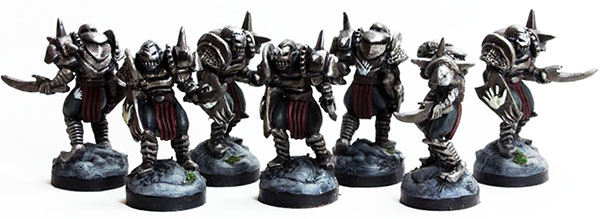
Armies
The bulk of the armed forces of a Nation are represented by Army units.
The Army units of a Nation are further divided into either Regular or Elite units, where the first category represents a fighting force of average warriors and the second a host of chosen fighters or powerful monsters.
A single Army unit corresponds to a variable number of warriors, from a few hundred expert fighters to thousands of Orcs. In game terms, all units of a kind (Regular or Elite) have the same fighting capabilities as any other of the same kind, regardless of the Nation they belong to.
All Army units inside a single region and controlled by the same player are considered a single group and are collectively called an Army.
An Army can be composed of a maximum of ten units, or five units if the Army is inside a Stronghold under siege.
Free Peoples Leaders
The captains and chieftains leading the Armies of the Free Peoples are represented by Leader figures.
Leaders are unable to move on their own and must always be part of a friendly Army. If at any time a Leader is on the map without an Army, he is immediately removed.
The presence of a Leader in an Army provides an advantage in combat and a superior movement capability. There is no limit to the number of Leaders who can be in the same Army. Free Peoples Leaders, regardless of nationality, can lead Armies composed of units from any Free Peoples Nation.
A Leader is not considered an Army unit and cannot be taken as a casualty, nor does the presence of a Leader add to the Combat Strength of an Army.
Nazgul
The Nazgul, also called Ringwraiths, act as Leaders for the Shadow Armies and each is represented by the distinctive Ringwraith figure mounted on a winged beast.
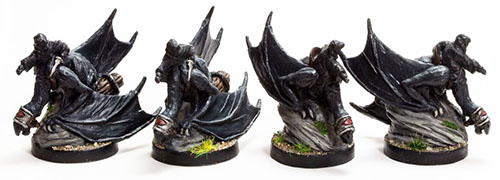
The rules pertaining to the Free Peoples Leaders also apply to the Nazgul, with the following exceptions:
-
The Nazgul are not obliged to be part of a friendly Army and can move on their own, flying to any region (even regions containing Free Peoples units) on the game board with a single movement.
Exception: a Nazgul moving without an Army cannot be placed alone in an enemy-controlled Stronghold.
-
The Nazgul are unaffected by the presence of an enemy Army in the same region.
Characters
The main heroes of the story and their main antagonists are represented by the Character figures.
Characters are personalities with abilities superior to those of simple Leaders. Characters belonging to the Free Peoples are called Companions, while the Characters of the Shadow are called Minions.
Each Character is represented by a unique figure and a Character card detailing his special skills. Players should carefully read all of the Character cards before playing the game.
In game terms, Characters act much the same as Leaders, but they do not suffer the same restrictions and can move on the game board on their own, ignoring the presence of enemy Armies.
Companions
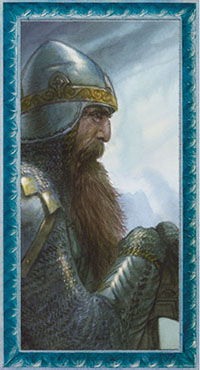
Legolas, Gimli, Boromir, Aragorn (as Strider), Meriadoc, Peregrin, and Gandalf the Grey start the game as the Companions of Frodo and Sam (the Ring- bearers) and members of the Fellowship of the Ring.
As the game progresses, they can leave the Fellowship to help rouse the Free Peoples Nations to war and to act as Leaders for the Free Peoples Armies.
Under certain conditions (as described on their Character cards), Strider and Gandalf the Grey can be replaced by their more powerful incarnations: Aragorn - Heir to Isildur and Gandalf the White.
 Aragorn - Heir to Isildur Marker
Aragorn - Heir to Isildur Marker
 Gandalf - the White Marker
Gandalf - the White Marker
When this happens, put the appropriate marker under the plastic figure of the Character to remember his new status.
Minions
The more prominent servants of the Dark Lord- Saruman, the Witch-king, and the Mouth of Sauron-do not start in play at the beginning of the game. They will enter play later, under the conditions specified on their Character cards.
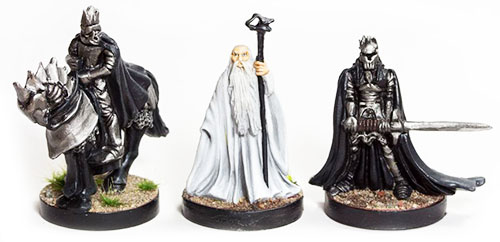
Gollum
Gollum is a very unusual Character. Gollum is always assumed to be following the Fellowship of the Ring, and he becomes the Guide of the Fellowship if the Ring- bearers are alone. When this happens, you may place the Gollum figure together with the Ring-bearers figure as a reminder of his presence. The effects of Gollum's actions are represented in the game by the Gollum Character card and certain Event cards.
The Game Board
The game board is a view of western Middle-earth at the end of the Third Age. In addition to the playing area proper, the game board also includes several spaces and tracks used to help the players keep track of various elements and components of the game.
The diagram of the game board identifies its various parts and shows the spaces where many of the components needed at the start of the game are placed during setup.

Map Examples

A white line is the normal border between two regions.

A river between two white lines is also a common style of border between two regions, which acts as a normal border.

A thick black line represents a mountain border, which can never be crossed.

A colored line running along a border shows the border of a Nation.

When two Nations are neighbors, two colored lines run along each other, separated by the white border.

Sea areas are not regions and can never be crossed. Regions bordering the large sea area on the left side of the board are called coastal regions.
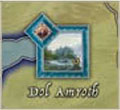
Larger letters in the name of a region show that the region includes a City or Stronghold.
Regions
The main portion of the game board shows a view of western Middle-earth at the end of the Third Age. The map is divided into territories called regions. Each region is identified by a name, which usually refers to a site of note or to an entire geographical area (such as Minas Tirith or Cardolan). Regions are used to regulate movement, combat, and the placement of all plastic figures.
Regions are normally separated by a white line or by a river between two white lines.
A thick black border denotes impassable terrain which cannot be crossed, usually a high mountain range. If the border between two regions is completely divided by such a line, those regions are not considered adjacent for any purpose.
Some areas of the board are completely blue, either surrounded by a black line or bordered by a white line. These areas are seas or lakes. A sea or lake area is not a region and can never be crossed or moved into.
Free Regions
The rules and Event cards often refer to a free region. A region is free for a player when it doesn't contain an enemy Army and/or an enemy-controlled Settlement. A region containing a Stronghold controlled by the enemy is also free for a player when the Stronghold is besieged by an Army of that player.
Nations
Several regions are grouped and identified as Nations by their colored borders (see diagram on page 9). Some Nations consist of several separate groups of regions, divided and distant from one another.
Fortifications And Settlements
A region can be empty, or contain either a Fortification or one of three types of Settlements (Town, City, or Stronghold).
Fortifications
A Fortification in a region offers easily defendable positions, such as a ruin, a fort, or a ford crossing a river. There are two Fortifications on the map: in the regions of Osgiliath and the Fords of Isen.

Settlements
Settlements represent locations that are vital to the economy and defense of a Nation. A region containing a Settlement gives several advantages to the player controlling it.
Towns represent populated areas that allow the recruitment of troops of a specific Nation. The presence of a Town is shown on the board by the symbol of the appropriate Nation.
 Free Peoples Town
Free Peoples Town
 Shadow Town
Shadow Town
Cities represent major urban centers and can also be used to recruit troops. They also provide an advantage in combat to defending troops.
 Free Peoples City.
Free Peoples City.
 Shadow City.
Shadow City.
Strongholds represent fortresses, Elven homes, and the greatest capitals of Middle-earth. Troops may be recruited in Strongholds, and defenders receive a very strong advantage in battle.
Note: Each Stronghold on the board is matched by a Stronghold Box with the same drawing (or with a generic drawing in the case of Shadow Strongholds).
 Shadow Stronghold.
Shadow Stronghold.
 Free Peoples Stronghold.
Free Peoples Stronghold.
The Cities and Strongholds of Middle-earth give Victory points to a player who captures them from the enemy.
In both Cities and Strongholds, the color of the frame shows which player initially controls it (red for the Shadow, blue for the Free Peoples). The icon in the upper corner shows which Nation the City or Stronghold belongs to.
The  symbol appearing on a City is a reminder that control of this region is worth 1 Victory point to the opponent.
symbol appearing on a City is a reminder that control of this region is worth 1 Victory point to the opponent.
The 
 symbol appearing on a Stronghold is a reminder that control of this Stronghold is worth 2 Victory points to the opponent.
symbol appearing on a Stronghold is a reminder that control of this Stronghold is worth 2 Victory points to the opponent.
Unconquered
Event cards may refer to an unconquered Settlement. A Settlement is unconquered if it is controlled by the same player who controlled it at the beginning of the game. A Settlement which was captured by the opponent, and then recaptured by its original owner, is "unconquered" once again. A Stronghold under siege is considered unconquered if the besieged Army belongs to the original owner.
Tracks And Boxes
In addition to the regions of Middle-earth, the game board also contains various boxes and tracks used during the game to keep track of different activities. These areas include:
- The Fellowship Track, to keep track of the progress of the Fellowship and the Corruption of the Ring- bearers.
- The Hunt for the Ring Box (also called the "Hunt Box"), to display the dice that the Shadow player allocates to hunt the Fellowship and to keep track of the number of times that the Fellowship moves during a turn.
- The Political Track, to keep track of which Nations of Middle-earth are "at War".
- The Guide of the Fellowship Box, to display the Character card of the Character who is guiding the Fellowship.
- The Fellowship of the Ring Box (also called the "Fellowship Box"), to display the figures and counters of the Companions composing the Fellowship.
- The Elven Rings Boxes, to display the Elven Rings counters.
- The Event Deck Boxes, to hold the four Event card decks.
- The Stronghold Boxes, to display those Army units involved in a siege battle.
- The Army Boxes, to hold figures when there is not enough space in a region.
- The Victory Point Track, to keep count of the conquests of each player.
- The Mordor Track, superimposed on the Gorgoroth region on the map, to keep track of the progress of the Fellowship when traveling in Mordor.
The Game Board


Continue Reading


